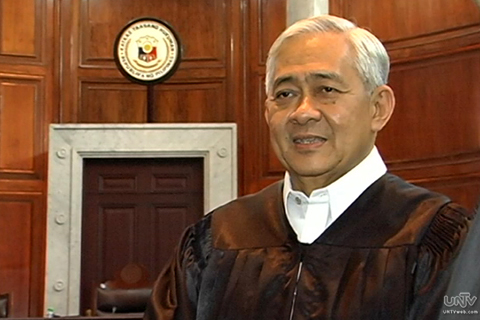
A Legal Sea Change in the South China Sea: Ramifications of the Philippines’ ITLOS Case
Publication: China Brief Volume: 14 Issue: 11
By:

Over the last year, it has become clear that China is determined to pursue its strategy of “salami slicing” in the South China Sea—gradually increasing its control through small moves that fall short of war. Beijing has not been deterred from this strategy by remonstrations from regional powers and the United States, increased military cooperation between rival claimants and Washington or its own push to improve relations with neighboring countries. The best bet for China’s neighbors to change its strategic calculus appears to be the approach of the Philippines: directly challenging Chinese territorial claims in international arbitration under the UN Convention on the Law of the Sea (UNCLOS).
On January 22, 2013, the Philippines filed a Notification and Statement of Claim at the International Tribunal for the Law of the Sea (ITLOS), seeking to invalidate China’s nine-dash Line, which encompasses virtually the entire South China Sea (Notification and Statement of Claim: https://www.pia.gov.ph/news/piafiles/DFA-13-0211.pdf). A ruling is not expected prior to 2015, but the submission is already sending shockwaves across the region. While China has attempted to isolate Manila in punishment, Vietnam has announced plans to seek legal recourse against China, which is a sign of preliminary political success for Manila.
However, there remains considerable uncertainty about the ruling: outcomes could range from validating China’s Three Warfares strategy to seriously undermining China’s soft power strategy and creating an opportunity for the United States to cast itself as a champion of international law.
Possible Outcomes
Declining Jurisdiction
The first possible outcome is that PCA decides it does not have jurisdiction to rule on the case, as China demands. Chinese commentators have argued that because China has rejected the arbitration and China refuses to participate, it cannot be bound by its decision. However, precedent suggests otherwise. In a previous case known as In the Matter of Arbitration between Barbados and the Republic of Trinidad and Tobago (2006), the tribunal explicitly recognized an applicant-State’s right to unilaterally bring a dispute to arbitration over the defending-State’s objections. [1] Furthermore, according to Article 9 of Annex VII to the UNCLOS, “[a]bsence of a party or failure of a party to defend its case shall not constitute a bar to the proceedings.” Consequently, it is almost certain that the argument that China’s non-appearance and non-participation bars jurisdiction will not prevail.
The second argument and more convincing China asserts to bar jurisdiction is based on substance and nature of the dispute. UNCLOS provides that States may submit a formal declaration to the UN Secretary-General providing notice to all parties that they refuse to accept the compulsory procedures for binding decisions for certain categories of disputes related to territorial sovereignty. In 2006 China made a formal declaration that it does not accept those procedures. The resulting argument is that this case is an attempt to indirectly secure the Philippines’ claim to the different islands, rocks and reefs in the South China Sea that the Philippines the PCA cannot rule on the legal status of China’s actions and installations in the South China Sea unless the tribunal undertakes maritime boundary delimitations to determine who has the right to exercise sovereignty or jurisdiction in the parts of the seabed on which they are located (Global Times, March 31; Xinhua, April 1; English.news.cn, April 3). If the tribunal accepts the Chinese position, then it might decline jurisdiction over the Philippines’ claims. In its Memorial, the Philippines attempted to parry these assertions by insisting that it does not seek either a determination of sovereignty over the islands, or a delimitation of maritime boundaries.
Ruling on the Claims
Assuming the PCA decides to rule on the case, the question is what the PCA will actually choose to address. If the PCA concludes that the nine-dash line is a question of territorial seas, then the PCA might decide to rule on only some of the Philippines’ pleadings, with the most likely being the status of the land features. Most analysts believe that nearly all of the land features in the region are “rocks” and will accordingly be granted a mere 12 nautical mile (nm) territorial sea, instead of a 200nm Exclusive Economic Zone (EEZ) allowed for “islands” pursuant to Art.121 of UNCLOS (https://www.eastasiaforum.org/2013/06/16/south-china-sea-dispute-dynamics/).
A third outcome is that the PCA rules on the status of the nine-dash-line as well. The PCA might avoid ruling on this issue on the grounds that the line is too vague because China has not submitted that line’s precise coordinates, and that China has not clarified what the line asserts sovereignty over (e.g., the land features only, everything within the line, etc.), and that it is neither consistent with nor or contrary to UNCLOS. Yet if the PCA accepts jurisdiction to rule on this question, then there is a strong likelihood that it will rule that the nine-dash line is incompatible with UNCLOS.
Impact of a Ruling
Any ruling will have an immediate impact on regional politics. If the PCA refuses to rule on this case China will likely see this refusal as a validation of its opting out of compulsory arbitration. This outcome would provide China with added leverage in its attempts to confine all dispute negations to the bilateral level.
If ITLOS invalidates the nine-dashed-line, the ruling would be a loss of face and a blow to all three of China’s “three warfare” efforts in the region (legal warfare, public opinion warfare and psychological warfare) emboldening challenges the Philippines, Vietnam, Malaysia and possibly Indonesia. These countries would be less likely to accept China’s insistence that all disputes be resolved bilaterally. Now bolstered by a clear ruling of its maritime rights issued by the highest legal authority for this issue, other competing claimants would be bolder about submitting ITLOS claims of their own, fishing in their claimed EEZs and awarding hydrocarbon exploration and drilling rights in their EEZs.
Among China’s rival claimants, optimism about the outcome of the case is spreading. The Philippines’ PCA submission appears promising enough that Vietnam has prepared evidence for a legal suit challenging China’s claim to waters off the Vietnamese coast and says that it is considering the best time to file it. Prime Minister Nguyen Tan Dung declared in an interview: “We are prepared and ready for legal action” (Bloomberg, May 30).
Even Japan has expressed an interest in international adjudication with China to resolve territorial disputes. Former Foreign Minister Koichiro Genba challenged China to do so in an op-ed published in the New York Times in November 2012. However, since then Genba’s government was replaced by current Abe administration, which has favored more military responses. Given that Tokyo asserts that there is no dispute over the Senkakus/Diaoyus, seeking recourse through legal means remains highly unlikely.
A legally binding ruling would also provide grounds for non-claimants such as the United States, Australia or Indonesia to become more active in support of the Philippines’ position.
But Will China Listen?
The most favorable possible ruling for the Philippines would not strip China of all legal rationales for its territorial claims in the South China Sea. The ruling would remove the nine-dash-line as a basis for those claims, but China’s claims over land features are not included in the case and will not be invalidated. China would still assert sovereign claims over the Paracel and Spratly islands, along with sovereignty over the territorial seas and potential EEZs surrounding them. However, the waters’ range would be greatly reduced if the PCA rules that those features are only “rocks.” Although legally binding to both parties, any ruling will have no formal enforcement mechanism (Article 11, Annex VII, UNCLOS).
Despite this, China will still have much to lose. China has hedged against this possibility in two ways: first, by working its economic, legal and diplomatic levers on other claimants in the hopes of preventing them from trying arbitration. China has to dissuade Manila from submitting its Memorial, allegedly including a mutual withdrawal of forces from the Second Thomas Reef and economic benefits to the Philippines, although Beijing has denied the reports (Rappler, February 26). Sticks could include a greater military presence at Scarborough Reef along with completely cutting off re-supply efforts of the BRP Sierra Madre at Second Thomas Reef, as well as economic coercion along the lines of what China implemented in 2012.
Manila is already seeking partners to help it resist Chinese attempts to defy a ruling. Reaching out to other regional powers with their own disputes with Beijing, it has strengthened relations with Japan, Vietnam and Indonesia. Leaders from the Philippines and Vietnam met in February, March and May this year to discuss Manila’s arbitration against China, while in 2013 Japan agreed to sell several patrol boats to the Philippine Coast Guard and the two countries’ defense ministers vowed to cooperate so that the rule of law prevailed in the settlement of territorial disputes (Asahi Shimbun, May 23, 2013). Manila has also expressed a willingness to provide Japanese maritime vessels with access to some of its naval facilities (InterAksyon.com, June 27, 2013). China’s actions are ensuring that this trend of greater Japan-Philippines cooperation will likely continue. Finally, the Philippines and Indonesia have recently improved their security relationship by resolving a maritime border dispute (BBC, May 3). The most important partner for Manila, however, is its treaty ally the United States, which has also provided increased political and military support.
If Vietnam does file an ITLOS claim, it will no doubt face retribution from Beijing—and may be offered similar inducements to withdraw the claim. But Hanoi appears to be digging in for a long period of tensions with China, following a similar template to Manila. It has sought to improve its relationships with the Philippines, India and Japan, making joint statements about the disputes (Kyodo News, May 22). Voices in Vietnam calling for a strategic partnership with the United States (cogitAsia, May 30). Hanoi recently joined the Proliferation Security Initiative, and expressed an interest in purchasing U.S. maritime surveillance aircraft and conducting joint training with the U.S. Coast Guard.
Conclusion
All claimants in the South China Sea face a range of outcomes from the PCA’s ruling. It has already prompted Vietnam to seek legal relief against China for its South China Sea actions. It could result in maintaining the status quo, or it could result in a sea change of behavior based on legal rights and national pride. Consequently, these parties are hedging against this range of outcomes, most notably further legal actions.
For Washington, a ruling could present an opportunity to align its preference for regional order with international law, thereby allowing it to present itself as a champion of the rights of small states and the use of law over hard power, while Chinese rhetoric is undermined. Such dynamics would hurt China’s efforts in its other regional territorial disputes, and potentially bolster U.S. regional soft power.
Notes
- In the Matter of an Arbitration between Barbados and the Republic of Trinidad & Tobago (Award of Apr. II, 2006), available at < https://www.pca-cpa.org/E?GLISHlRPC/ >.
- UNCLOS Article 298 (1).
- Declaration under Article 298 by the Government of the People’s Republic of China (August 25, 2006), see online: < https://www.un.org/depts/los/settlement_of_disputes/choice_procedure.htm >.





